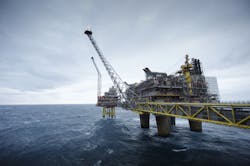Equinor, Norwegian authorities take steps to meet European gas demand
Equinor ASA and partners, together with Norwegian authorities, are working to meet gas demand in Europe through adjusted production permits and postponed turnarounds. Increased production permits have been approved for Troll, Oseberg, and Heidrun fields offshore Norway to help maintain high gas production through the summer months.
The Ministry of Petroleum and Energy has approved a more flexible production permit for Oseberg field, to increase gas exports by about 1 billion cu m to about 7 billion cu m, to Sept. 30, 2022. This is a 15-20% increase for the current gas year. Gas production on Heidrun will increase by 400 million cu m in the current calendar year, representing an increase of up to about 30%.
The adjustments also increase exports via the Kollsnes processing plant. Production from Troll field could increase 1 billion cu m to 38 billion cu m of gas for the current gas year, an increase of slightly less than 3%, in the event of loss of production from other fields.
To further maintain supply, Equinor will postpone turnarounds on four platforms on Oseberg field to September from May, accelerating production of about 500 million cu m.
Expected to come on stream mid-May, the Hammerfest LNG plant on Melkoya Island in northern Norway will add over 6 billion cu m/year of gas from the Barents Sea. The plant has been closed since a Sept. 28, 2020 fire on the air intake of one of its five gas turbines (OGJ Online, Sept. 28, 2020; Oct. 2, 2020; Apr. 26, 2021).
Typically, 1.4 billion cu m of gas meets the gas demand of around 1.4 million European homes during a year.
About the Author
Alex Procyk
Upstream Editor
Alex Procyk is Upstream Editor at Oil & Gas Journal. He has also served as a principal technical professional at Halliburton and as a completion engineer at ConocoPhillips. He holds a BS in chemistry (1987) from Kent State University and a PhD in chemistry (1992) from Carnegie Mellon University. He is a member of the Society of Petroleum Engineers (SPE).

